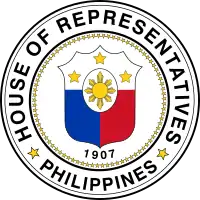Nicolas Rafols
Nicolas Mercado Rafols Jr. (1894 – May 2, 1947) was a Filipino Visayan legislator, journalist, businessman,[1] lawyer, and agriculturalist from Cebu, Philippines.[2] He was a member of the House of Representatives for Cebu's 6th District for multiple terms (1922–1925, 1928–1930, 1934–1938, 1945–1947).
Nicolas Rafols | |
|---|---|
| Member of the House of Representatives for Cebu's 6th District | |
| In office 1922–1925 | |
| Preceded by | Miguel Raffiñan |
| Succeeded by | Pastor Noel |
| In office 1928–1931 | |
| Preceded by | Pastor Noel |
| Succeeded by | Miguel Raffiñan |
| In office 1934–1938 | |
| Preceded by | Miguel Raffiñan |
| Succeeded by | Miguel Raffiñan |
| In office 1941–1947 | |
| Preceded by | Miguel Raffiñan |
| Succeeded by | Manuel Zosa |
| Personal details | |
| Born | 1894 Toledo, Cebu, Philippines |
| Died | May 2, 1947 |
| Nationality | Filipino |
| Alma mater |
|
| Profession |
|
Early life
Rafols was born in Toledo, Cebu to Ignacia Mercado and Nicolas Rafols Sr. in 1894. He went to a public school in Toledo and then studied at Liceo de Manila (1904–1908)[1] with a bachelor of arts degree. Later, he went to study law at Escuela de Derecho in Manila[2] from 1909 until 1911.[1]
Career
As a journalist, he edited several newspapers including El Precursor and El Democrata.
Writing under the pseudonyms Enarem and Niramer, he had written a collection of poetry, Damgo (Feelings), in 1918. Furthermore, he also compiled an collection of Cebuano writing in four volumes named Ang Kalibutan sa Katitikang Binisaya (The World of Visayan Letters) around 1947. However, he died before the work could be published.
His historical fiction, Ang Pulahan, was published in 1919 and one the early novels in Cebuano literature.[2] It was characterized as exhibiting realist tradition and discussed the rise of the pulahanes or renegade groups against the abuses of the constabulary[3] and against injustices committed by the Americans.[4] Vicente Rama, who was then the publisher of Cebuano Bag-ong Kusog, reviewed the novel, "What I like in this books is that even as its pages are filled with love's sighs, it is not lacking in worthwhile lessons that should be remember by both young and old."[5]
Political career
Rafols made his first public appearance at a political meeting held at the Teatro Oriente (the Old Teatro Junquera) on December 20, 1918. Moreover, he was part of the group that organized the Cebu branch of Partido Democrata Nacional, whose political rivals were the Nacionalista Party. In his residence in San Nicolas where the Democrata convention was held on January 15, 1922, he was nominated to be the party's representative for Cebu's old 6th congressional district,[6] which at that time was composed of the towns of Aloguinsan, Barili, Dumanjug, Pinamungajan, Ronda, and Toledo.[7]
He ran for elections, won, and served as representative in the 6th Philippine Legislature from 1922 until 1925, 8th Philippine Legislature from 1928 until 1930, and 10th Philippine Legislature from 1934 until 1935. Later on, he was a delegate to the First National Assembly from 1935 to 1938 and a delegate to the 1935 Constitutional Convention. He continued to serve as representative in the 1st Congress of the Commonwealth (1945), 2nd Congress of the Commonwealth which was also known as the 1st Congress of the Republic from 1946 until his untimely death on May 2, 1947. Manuel Zoza replaced Rafols when the former won in a special election that was held in November on 11, 1947.[8]
Published works
For his works printed in Bag-ong Kusog, see Cebuano Studies Center.[1]
Historical commemoration
External links
References
- "Nicolas Rafols". Cebuano Studies Center. May 11, 2015. Retrieved December 31, 2018.
- Mabolokon, Maria (July 7, 2011). "Nicolas Rafols". Cebuano Studies Center. Retrieved December 31, 2018.
- "NOVEL" (PDF). National Library of the Philippines. Archived from the original (PDF) on August 28, 2017. Retrieved December 31, 2018.
- Oaminal, Clarence Paul (February 12, 2018). "Nicolas Rafols St. (in honor of a Cebuano legislator-writer) | The Freeman". The Philippine Star. Philippine Star. Retrieved December 31, 2018.
- Resil, Dr. Mojares (1973). "THE FUNCTIONS OF LITERATURE: THE CEBUANO WRITER'S VIEW". Philippine Quarterly of Culture and Society. 1 (4): 283–288. JSTOR 29791098.
- Oaminal, Clarence Paul (December 9, 2013). "Nicolas Rafols Street, Cebu City". pressreader.com. Philippine Star. Retrieved December 31, 2018.
- Oaminal, Clarence Paul (August 24, 2017). "Nicolas Rafols St. (an unimplemented street naming ordinance) | The Freeman". The Philippine Star. Retrieved December 31, 2018.
- "ROSTER OF PHILIPPINE LEGISLATORS". House of Representative: Republic of the Philippines. Retrieved December 31, 2018.
